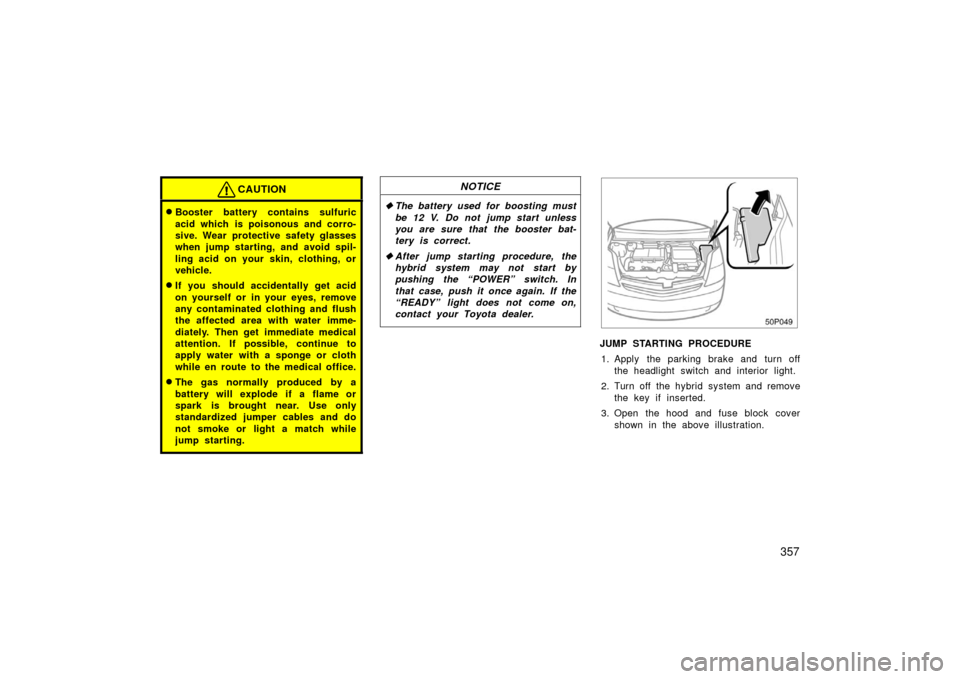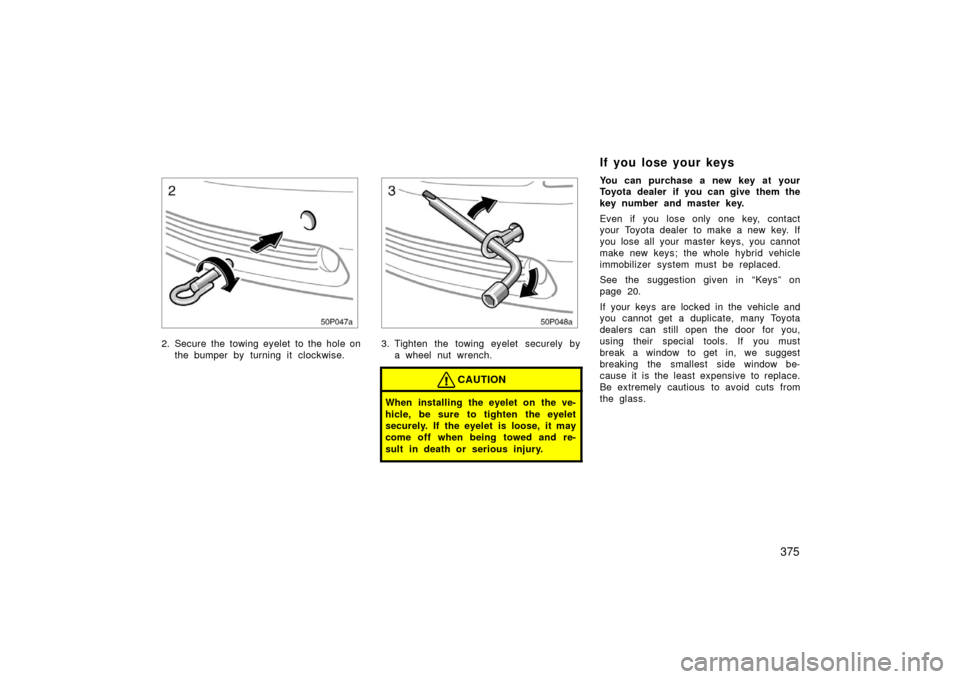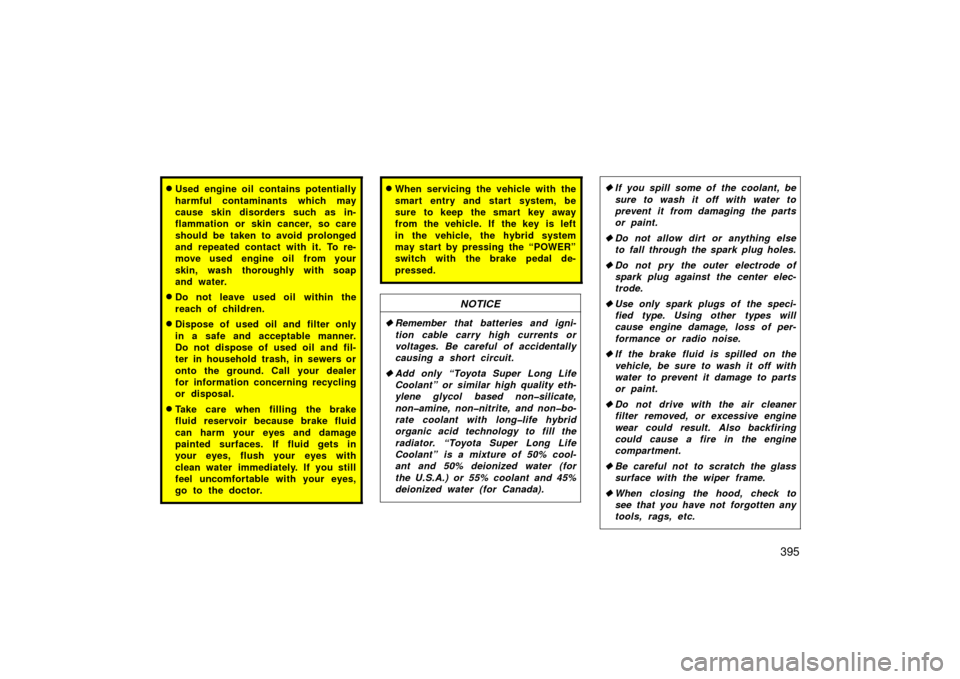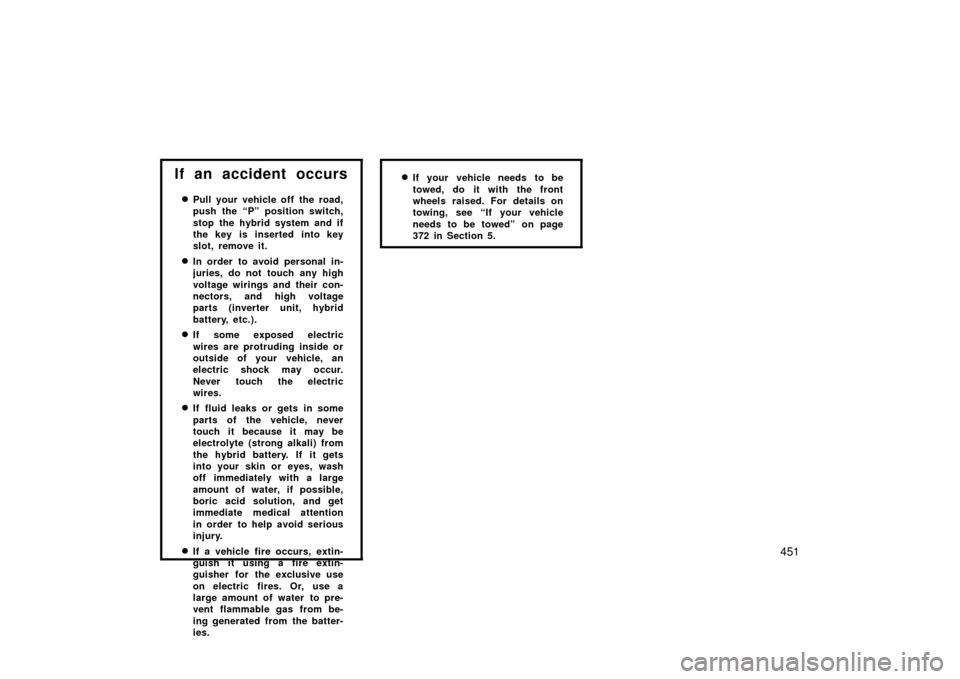Page 357 of 455

357
CAUTION
�Booster battery contains sulfuric
acid which is poisonous and corro-
sive. Wear protective safety glasses
when jump starting, and avoid spil-
ling acid on your skin, clothing, or
vehicle.
�If you should accidentally get acid
on yourself or in your eyes, remove
any contaminated clothing and flush
the affected area with water imme-
diately. Then get immediate medical
attention. If possible, continue to
apply water with a sponge or cloth
while en route to the medical office.
�The gas normally produced by a
battery will explode if a flame or
spark is brought near. Use only
standardized jumper cables and do
not smoke or light a match while
jump starting.
NOTICE
�The battery used for boosting must
be 12 V. Do not jump start unless
you are sure that the booster bat-
tery is correct.
� After jump starting procedure, the
hybrid system may not start by
pushing the “POWER” switch. In
that case, push it once again. If the
“READY” light does not come on,
contact your Toyota dealer.
50p049
JUMP STARTING PROCEDURE
1. Apply the parking brake and turn off the headlight switch and interior light.
2. Turn off the hybrid system and remove the key if inserted.
3. Open the hood and fuse block cover shown in the above illustration.
Page 375 of 455

375
50p047a
2. Secure the towing eyelet to the hole onthe bumper by turning it clockwise.
50p048a
3. Tighten the towing eyelet securely bya wheel nut wrench.
CAUTION
When installing the eyelet on the ve-
hicle, be sure to tighten the eyelet
securely. If the eyelet is loose, it may
come off when being towed and re-
sult in death or serious injury.
You can purchase a new key at your
Toyota dealer if you can give them the
key number and master key.
Even if you lose only one key, contact
your Toyota dealer to make a new key. If
you lose all your master keys, you cannot
make new keys; the whole hybrid vehicle
immobilizer system must be replaced.
See the suggestion given in “Keys” on
page 20.
If your keys are locked in the vehicle and
you cannot get a duplicate, many Toyota
dealers can still open the door for you,
using their special tools. If you must
break a window to get in, we suggest
breaking the smallest side window be-
cause it is the least expensive to replace.
Be extremely cautious to avoid cuts from
the glass.
If you lose your keys
Page 395 of 455

395
�Used engine oil contains potentially
harmful contaminants which may
cause skin disorders such as in-
flammation or skin cancer, so care
should be taken to avoid prolonged
and repeated contact with it. To re-
move used engine oil from your
skin, wash thoroughly with soap
and water.
�Do not leave used oil within the
reach of children.
�Dispose of used oil and filter only
in a safe and acceptable manner.
Do not dispose of used oil and fil-
ter in household trash, in sewers or
onto the ground. Call your dealer
for information concerning recycling
or disposal.
�Take care when filling the brake
fluid reservoir because brake fluid
can harm your eyes and damage
painted surfaces. If fluid gets in
your eyes, flush your eyes with
clean water immediately. If you still
feel uncomfortable with your eyes,
go to the doctor.
�When servicing the vehicle with the
smart entry and start system, be
sure to keep the smart key away
from the vehicle. If the key is left
in the vehicle, the hybrid system
may start by pressing the “POWER”
switch with the brake pedal de-
pressed.
NOTICE
�Remember that batteries and igni-
tion cable carry high currents or
voltages. Be careful of accidentally
causing a short circuit.
� Add only “Toyota Super Long Life
Coolant” or similar high quality eth-
ylene glycol based non�silicate,
non�amine, non�nitrite, and non�bo-
rate coolant with long�life hybrid
organic acid technology to fill the
radiator. “Toyota Super Long Life
Coolant” is a mixture of 50% cool-
ant and 50% deionized water (for
the U.S.A.) or 55% coolant and 45%
deionized water (for Canada).
�If you spill some of the coolant, be
sure to wash it off with water to
prevent it from damaging the parts
or paint.
� Do not allow dirt or anything else
to fall through the spark plug holes.
� Do not pry the outer electrode of
spark plug against the center elec-
trode.
� Use only spark plugs of the speci-
fied type. Using other types will
cause engine damage, loss of per-
formance or radio noise.
� If the brake fluid is spilled on the
vehicle, be sure to wash it off with
water to prevent it damage to parts
or paint.
� Do not drive with the air cleaner
filter removed, or excessive engine
wear could result. Also backfiring
could cause a fire in the engine
compartment.
� Be careful not to scratch the glass
surface with the wiper frame.
� When closing the hood, check to
see that you have not forgotten any
tools, rags, etc.
Page 429 of 455

429
12 VOLT BATTERY
Open voltage at 20�C (68 �F):
12.6 − 12.8 V Fully charged
12.2 − 12.4 V Half charged
11 . 5 − 11.9 V Discharged
[Voltage that is checked 20 minutes after
the key is removed with all the lights
turned off]
Charging rates: 3.5 A max.
HYBRID TRANSAXLE
Fluid capacity (drain and refill),
L (qt., Imp.qt.): 3.6 (3.8, 3.2)
Fluid type: “Toyota Genuine ATF WS” or
equivalent
Please contact your Toyota dealer for further
details. BRAKES
Minimum pedal clearance when depressed
with the force of 196 N (20 kgf, 44 lbf)
with the traction motor running, mm (in.):
101.0 (3.98)
Pedal free play, mm (in.): 1 − 4 (0.04 − 0.16)
Parking brake adjustment when depressed
with the force of 294 N (30 kgf, 66 lbf): 6 − 9 clicks
Fluid type: SAE J1703 or FMVSS No. 116 DOT 3
STEERING
Wheel free play: Less than 30 mm (1.2 in.)
Tires
Tire size and inflation pressure:
Tire size kPa (kgf/cm
2 or ba r, ps i )
Standard Front
P185/65R15 86S 240 (2. 4, 35)
Rear
P185/65R15 86S 230 (2. 3, 33)
Spare T125/70D16 96M 420 (4. 2, 60)
Wheel size: Standard 15 x 6JJ
S par e 16 x 4T
Wheel nut torque, N·m (kgf·m,
ft·lbf): 103 (10.5, 76)
NOTE: For a complete information on tires (e.g. replacing tires
or replacing wheels), see
“Checking tire inflation pres-
sure” through “Aluminum
wheel precautions”, page
405 through 412.
Page 446 of 455

446
Smart entry and startsystem
Users of any electrical medical de-
vices such as implanted pacemak-
ers should consult the manufactur-
er of the device for information
about its operation under the influ-
ence of radio waves. Radio waves
could have unexpected effects on
the operation of such medical de-
vices. For details, see “Keys” on
page 20 and “Smart entry and
start system” on page 24 in Sec-
tion 2−1.
Tires and loading on
your Toyota
Underinflated or overinflated
tire inflation pressure and the
excess load may result in the
deterioration of steering ability
and braking ability, leading to
an accident. Check the tire
inflation pressure periodically
and be sure to keep the load
limits given in this Owner ’s
Manual. For details about tire
inflation pressure and load lim-
its, see page 405 and pages
342.
Scrapping of your Toyota
The SRS airbag and seat belt pre-
tensioner devices in your Toyota
contain explosive chemicals. If the
vehicle is scrapped with the airbags
and pretensioners left as they are,
this may cause an accident such as
fire. Be sure to have the systems
of the SRS airbag and seat belt
pretensioner removed and disposed
of by the qualified service shop or
by your Toyota dealer before you
dispose of your vehicle.
Page 451 of 455

451
If an accident occurs
�Pull your vehicle off the road,
push the “P” position switch,
stop the hybrid system and if
the key is inserted into key
slot, remove it.
�In order to avoid personal in-
juries, do not touch any high
voltage wirings and their con-
nectors, and high voltage
parts (inverter unit, hybrid
battery, etc.).
�If some exposed electric
wires are protruding inside or
outside of your vehicle, an
electric shock may occur.
Never touch the electric
wires.
�If fluid leaks or gets in some
parts of the vehicle, never
touch it because it may be
electrolyte (strong alkali) from
the hybrid battery. If it gets
into your skin or eyes, wash
off immediately with a large
amount of water, if possible,
boric acid solution, and get
immediate medical attention
in order to help avoid serious
injury.
�If a vehicle fire occurs, extin-
guish it using a fire extin-
guisher for the exclusive use
on electric fires. Or, use a
large amount of water to pre-
vent flammable gas from be-
ing generated from the batter-
ies.
�If your vehicle needs to be
towed, do it with the front
wheels raised. For details on
towing, see “If your vehicle
needs to be towed” on page
372 in Section 5.